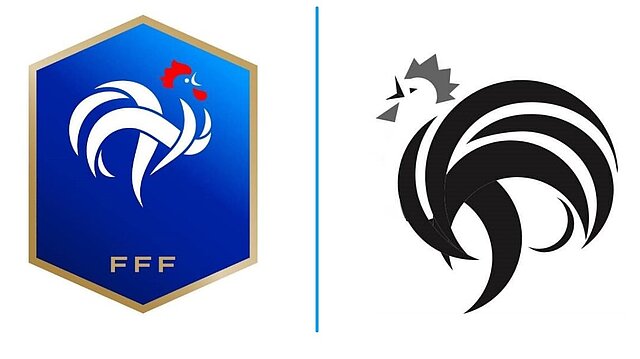In 2021, the applicant filed an application of EU trademark for the representation of a rooster and for designating “Headgear; footwear; clothing” in class 25.
Opposition was filed by Fédération française de football based on its FFF trademark representing also a rooster and designating identical goods in class 25.
Considering that there is likelihood of confusion between the trademark, Opposition division upheld the opposition. Board of Appeal confirmed the decision and dismissed the Appeal of the applicant.
The General Court confirms also the likelihood of confusion:
- the trademark application consists of a single figurative element, a stylised rooster facing to the left, depicted in black and white and in shades of grey;
- the earlier trademark is a composite mark composed of three golden letters F and a stylised rooster, in white and red colours, which is facing to the right, all placed on a hexagonal background in blue with a golden outline.
Both the verbal and figurative parts are distinctive for designating goods in class 25.
The Board and the Court find that the figurative element, because of its size and position, is the dominant element.
When comparing visually the signs, the Court underlines that both roosters are stylised in essentially the same manner:
- the plumage represents the bodies of the roosters, the feathers being represented by a series of curves, arranged in the same way in both signs;
- the heads contain no outline and are made up of four elements drawn in a fairly basic manner: a dot indicating the eye, a chevron shape representing the open beak and drawings of the characteristic barbel and crest of a rooster;
- the rosters have no visible legs, in so far as the body of the roosters appears to balance on a feather.
The differences between the signs in question, relating to the word element ‘FFF’ and to the decorative elements of the earlier mark, cannot offset the similarity of the figurative elements representing a stylised rooster.
The Court concludes that there is an average degree of similarity for the visual aspect, whereas the Board considered the degree of similarity as “at least below-average”.
Regarding conceptual comparison, both signs refer to the same concept, namely that of a highly stylised and impressionistic rooster, the Board of Appeal should have found that those signs were conceptually identical rather than highly similar.
In a global assessment, the General Court then concludes to likelihood of confusion.
T‑104/24 of 15/01/2025
CABINET CHAILLOT
PATENTS TRADEMARKS DESIGNS
French Patent & Trademark Attorneys - European Patent Attorneys - Representatives before EUIPO
ISO 9001 CERTIFIED

